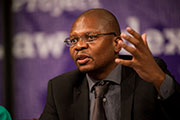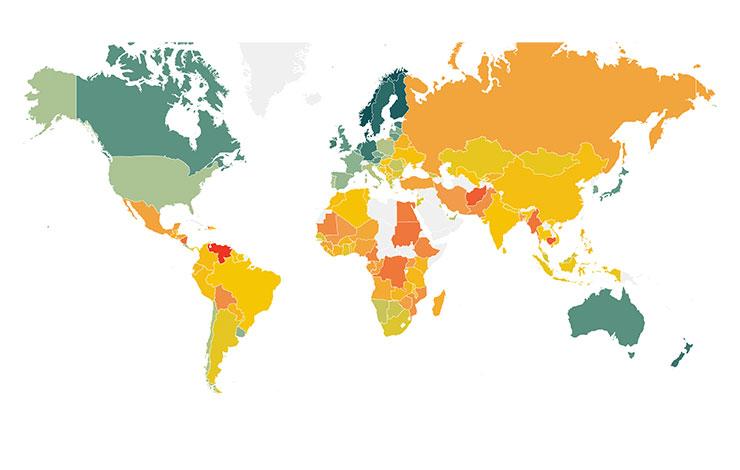
On February 24th and 25th Italian parliamentary elections will be held. The electoral system in place is referred to in Italy as the "Calderoli law", approved in 2005 and already used in the 2006 and 2008. Both the Chamber of Deputies and the Senate are elected with a proportional system with a majority premium. The two systems however are not identical.
For the Chamber of Deputies it is a majority-assuring system. The party or coalition of parties that gets a plurality of the votes at the national level is guaranteed 54% of the seats (340) regardless of its percentage of votes [JT: Unless it gets more than 54% of the vote - which won't happen in this election - but in that case it would get the correct proportion. It is only a bonus, never a penalty.] In the case of coalitions the votes of all its parties are counted for determining who gets the majority bonus. The remaining seats are allocated proportionally among the losers which meet the conditions for gaining representation. For parties running alone the threshold for getting seats is 4%. For parties running in coalition the threshold is 2%, provided their coalition gets at least 10% of the votes. For each coalition with more than 10% the largest party below the 2% threshold is entitled to receive seats. Party lists are closed.
For the Senate the system is similar to that of the Chamber but it is not majority-assuring. The major difference is that the majority bonus is allocated at the regional level. In 17 out of 20 regions the party or coalition of parties that gets a plurality of the votes is guaranteed 55% of the seats assigned to each region regardless of its percentage of votes. In the case of coalitions the votes of all parties in the coalition are counted for determining who gets the majority bonus. The remaining seats are allocated proportionally among the losers which meet the conditions for gaining representation. For parties running alone the threshold for receiving seats is 8%. For parties running in coalition the threshold is 3%, provided their coalition gets at least 20% of the votes. Party lists are closed.
The regional allocation of the majority premiums in the Senate makes it difficult achieving an absolute majority of seats. Even a party or coalition with a 5-8 percentage point lead at the national level might not be able to get 158 out of 350 seats. This can happen if it loses in 2 of the largest regions and it is particularly true in a multipolar situation such as exists now.
An important element to consider is that in our parliamentary system the government must receive a confidence vote by both Houses. A non-confidence vote by either of the two legislative houses entails the resignation of the government. [JT: My sense is this is very uncommon, to need the confidence of both houses of parliament to stay in office. Does anyone know other examples? If so, pelase leave in comments].
Another important difference between the Chamber and the Senate electoral systems is voting age: all citizens above 18 years can vote for the Chamber, but only those who are at least 25 can vote for the Senate.[JT: Again, anyone know any other countries where this is the case??] So there are nearly 5 million Italians who only vote for the Chamber of Deputies. It's about 10% of total voters. There is no guarantee that the results will be the same in the two houses. In 2006 Prodi's coalition won a plurality in the Chamber but Berlusconi’s received more votes in the Senate. It was only thanks to the 6 seats allocated in the constituency for "Italians living abroad" that Prodi was able to get a majority of one.
Five years ago, in the previous general election, Berlusconi's coalition received 46,8% of valid votes for the Chamber gaining the 340 seats. His party, Pdl (Freedom People), had 37,4% and 272 seats. His older and most loyal ally, the Northern League, gained 60 seats with 8,3% of the votes; the Movement for autonomies (Mpa), the third party of the coalition, gained 8 seats even though it had only 1,1% of the vote. The Democratic Party (Pd) had 33,2% of valid votes and 211 seats, its coalition ally, Di Pietro's Idv (Italy of Values) got 28 seats with 4,4% of the vote. The only other party who obtained representatives was Casini's Udc (Center Union): 5,6% of the votes and 36 seats. A total of 6 national parties entered the Chamber. This was a very low number for Italian political system. Only two years earlier, in the 2006 general elections, 10 parties gained representation with the same electoral system.
In the Senate Berlusconi won 12 regions. This was enough to gain an absolute majority because the 5 regions where he lost contributed less than 20% of total senatorial seats. His coalition had a total of 174 seats against the 136 of the center-left and the 3 of Udc. So for the third time in Italian history he formed a government at the beginning of the legislature.
In late 2010 the government suffered the defection of the President of the Chamber Fini and a group of his followers who formed a new party: Future and Liberty for Italy (Fli). This defection forced a no-confidence vote on December 14th: the government barely survived thanks to defections from opposition groups.
In November 2011, after having lost an explicit majority in the Chamber and with the spread between Italian and German 10 year Treasury bonds above 500 points, Berlusconi finally resigned on the 12th. The President of the Republic Napolitano appointed as prime minister Mario Monti, an academic economist and former UE commissioner who had never run for office before. His government, entirely composed by experts, received a very large confidence vote in both Houses, being supported by Pdl, Pd, Udc and Fli. The tally in favor was 281 votes in the Senate and 556 in the Chamber.
The top priority of the new cabinet was reassuring financial markets and UE partners through austerity measures. The first and most important measure was the reform of the pension system. Another important reform was the reintroduction of a property tax that had been abolished by Berlusconi. In the first months the new government was perceived as the county savior and had an exceptionally high popularity rating, in spite of the tough reforms carried forward. Parties were unable to do anything but support the government's proposals.
During 2012 the government tried to make a series of reforms, but the parties gradually regained leverage and were able to stop or change them so as not to hurt their constituencies. This happened for example with the labor-market reform which fell short of what the government wanted to achieve because of the resistance of the unions and the Pd. The same is true of the new law on corruption which was diluted as a result of Pdl opposition. In the meantime the economic recession hit even harder and the social crisis became worse, leaving the government in a difficult position that cost it much of its earlier popularity.
In November the center-left coalition organized primary elections to select its candidate for prime minister. The members of the coalition are the Democratic Party (Pd), Italian Socialist Party (Psi), Democratic Center, and Left Ecology and Liberty (Sel). Pierluigi Bersani, the Pd secretary, won against Florence major Renzi in the second round (December 2nd). At that time all polls showed his coalition with a large advantage over its rivals. It was was running above 40% and remained at that level until the end of the year. As a front runner Bersani considered himself the "rabbit on the run" and he developed a very conservative campaign strategy that has probably cost him some votes in the long run.
On December 6th Pdl secretary Alfano announced in a parliamentary speech the intention of his party to withdraw its support to the Monti cabinet. Two days later Monti announced his resignation, to become effective after the budget bill for fiscal year 2013 had been approved.
A few days later Berlusconi said he would not run if Monti would accept an offer to lead a center-right coalition, formed by Pdl, Udc, Fli and maybe Northern League. Monti refused the offer and soon after announced his decision to run. He presented his political program, referred to as the 'Monti agenda', declaring that his goal was to unite reformers both on the left and on the right of the political spectrum in order to overcome the rigidity of what he considered an obsolete bipolar pattern of competition. He followed the announcement with the creation of his own party, Civic choice, which entered a coalition with Udc and Fli. In the Senate the three parties chose to run as a single list because of the 8 % threshold.
Berlusconi then recreated his traditional alliance with the Northern League. Originally the League had resisted this option but its resistance dropped when Berlusconi agreeded to support the League leader, Roberto Maroni, in his bid to become governor of Lombardy, the most important Italian region. Lombardy regional election will be held the same day of the national elections. Besides the League the Berlusconi coalition includes other minor allies whose number varies from region to region. After organizing the coalition, Berlusconi started a massive campaign of television interviews and talk show appearances which paid off in the polls. His main issue has been tax relief, including the reimbursement of the property tax introduced by the Monti government for whom his party had voted in Parliament. He also started to blame Monti and his policies for the worsening of the economic situation, describing him (Monti) as his (Berlusconi's) biggest political regret.
Figure 1 – Weekly polls by IPSOS for the TV program Ballarò.
In the last weeks of the campaign the one candidate who has been very visible, and the only one who is bringing the crowds out, is Beppe Grillo. He is a former television comedian and the founder of the 5 star movement (M5s). For the past two years this movement was present only in local elections. Being a populist and anti-establishemnt movement it is very hard to locate on a right-left axis. It has attracted votes both from former center-left and center-right voters. Thanks to the "Tsunami tour" of its leader, it is gaining attention and votes and is now in third place with a chance to move to second. The recent corruption scandals like the Monte dei Paschi and Finmeccanica have given to it a big boost.
As of February 9th no polls can legally be published in Italy. The last data published (see above) show a lead of 5-6 percentage points in favor of Bersani, with Berlusconi around 28 % and Monti and Grillo at 15%. If they are correct the most probable outcome of the vote is a Bersani win in the Chamber. At least 10 parties will get seats, even if Civil Revolution (the union of parties on Pd's left) should remain below the 4% threshold.
It is tougher to predict the result of the Senate since the electoral system creates a sort of lottery of 17 regional premiums. Berlusconi is expected to win in Sicily and Veneto. if he manages to conquer one of the other battleground regions (Lombardy, Campania, Friuli, Apulia, Piedmont), Bersani would not have an absolute majority. In that case a Monti-Bersani cabinet is the most likely outcome. This is a key point in the campaign strategy of all major parties. Bersani has repeatedly said that even if he won an absolute majority, he would ally himself with all truly Europeanist and anti-populist forces in order to solve together Italy's huge problems. His major ally, Sel's leader Vendola, has taken a different position, questioning the possibility of governing with Monti. The incumbent prime minister replied that if Bersani wants to cooperate with him he needs to choose between him and the extremists. All of this sounds however as campaign posturing. At the end of the day, if polls do not lie, after February 25th Italy will be governed by a coalition that will include Vendola, Bersani and Monti with Bersani as prime minister. How long will it last is a different matter.
Table 1 – Senate seats according to regional polls by Tecnè for SkyTv published on February 7th.
NOTE: in red the regions where the majority bonus is assigned to the Bersani's coalition; in blue the regions assigned to the Berlusconi's coalition.
This article was originally posted by Professor Joshua Tucker on The Monkey Cage.








